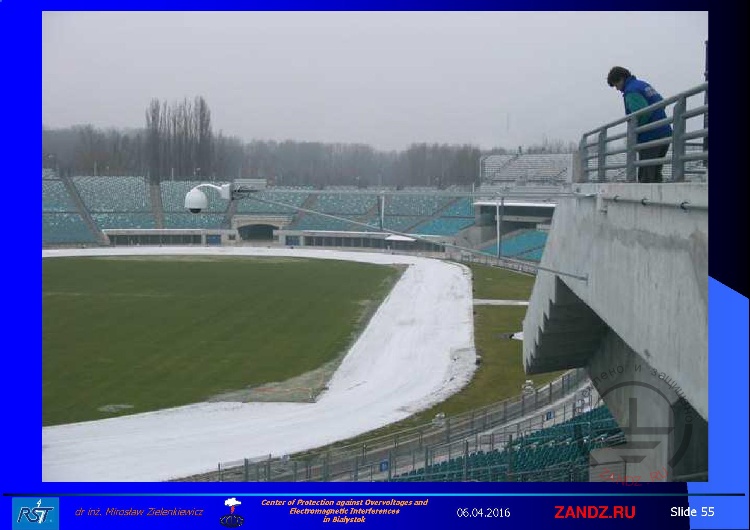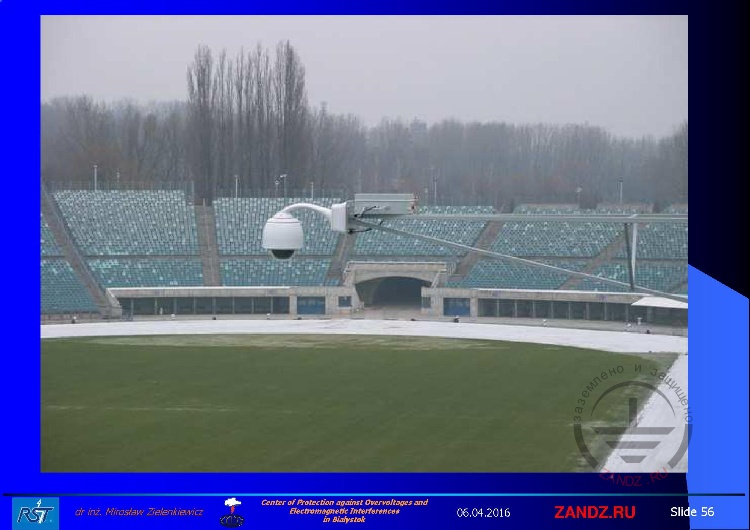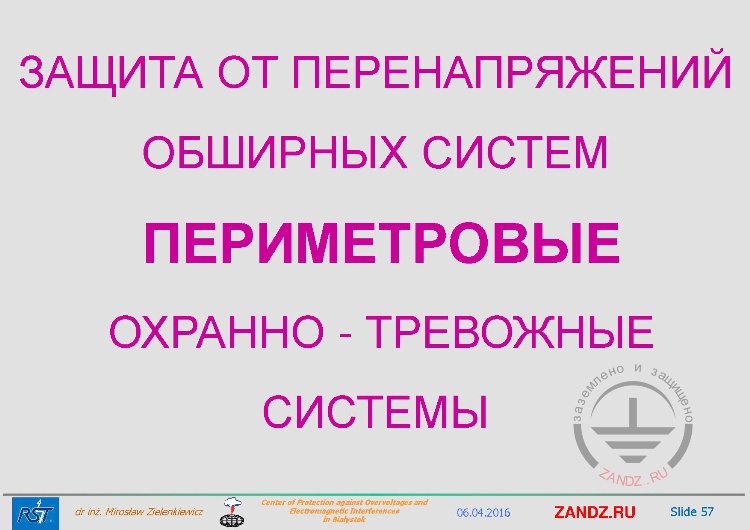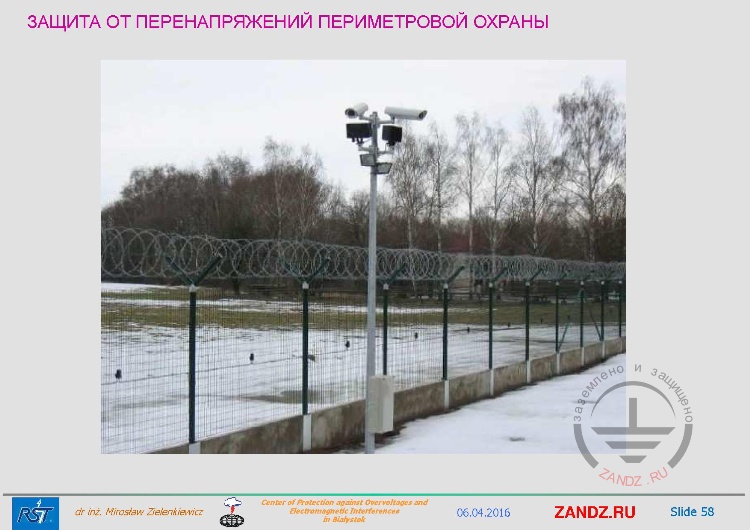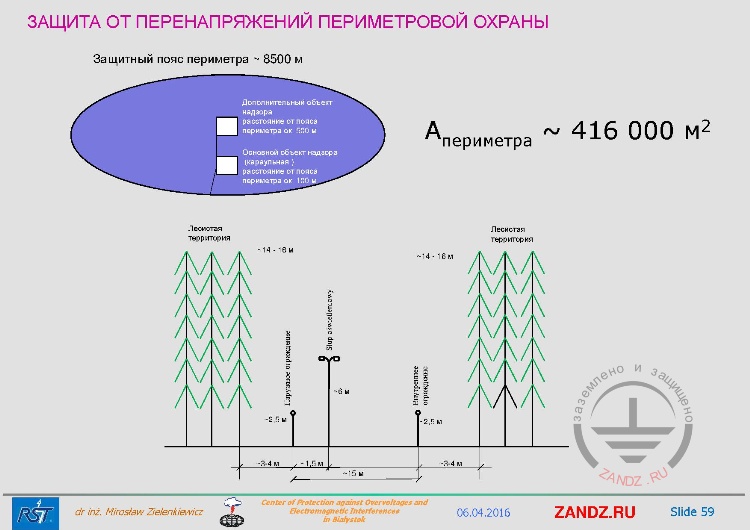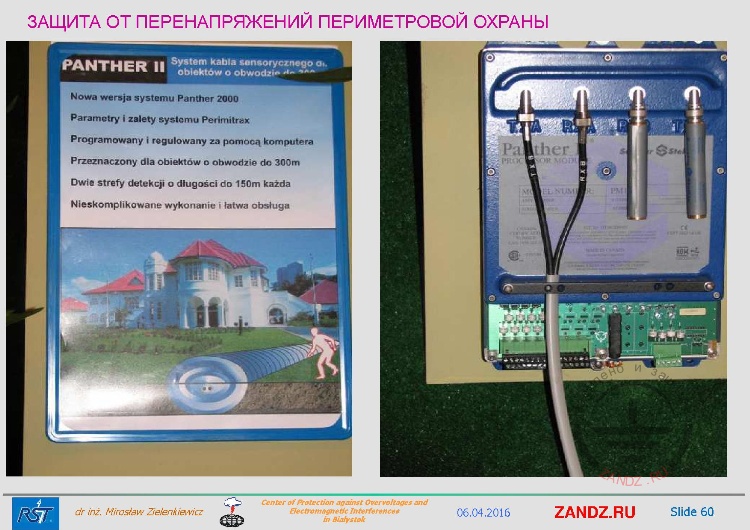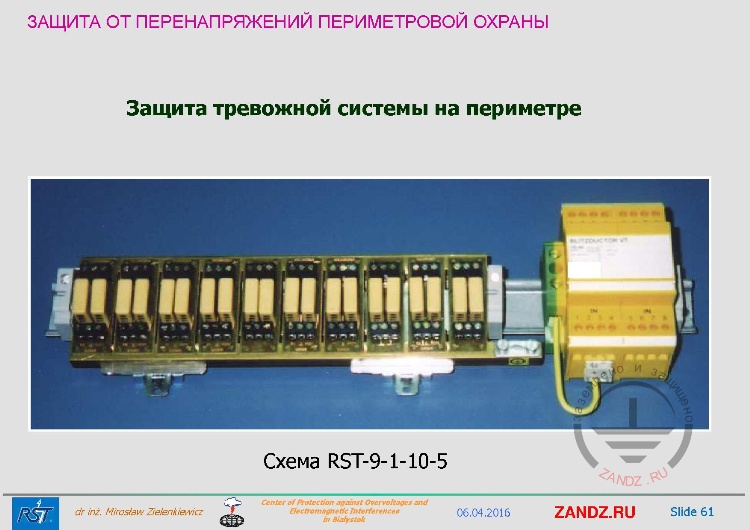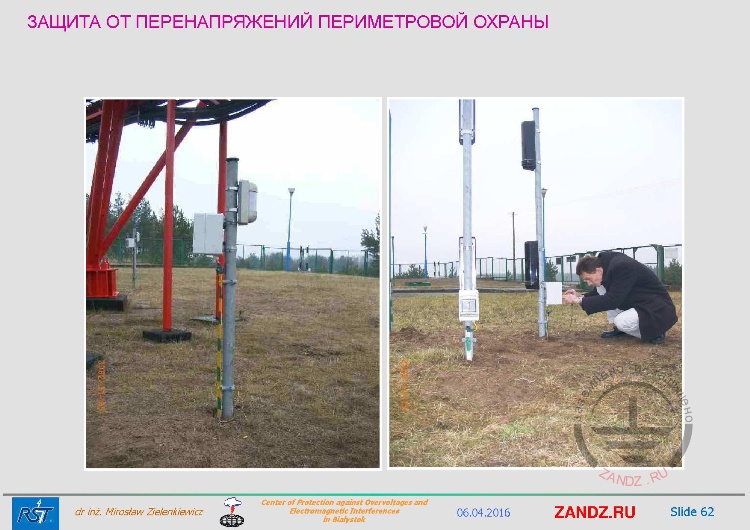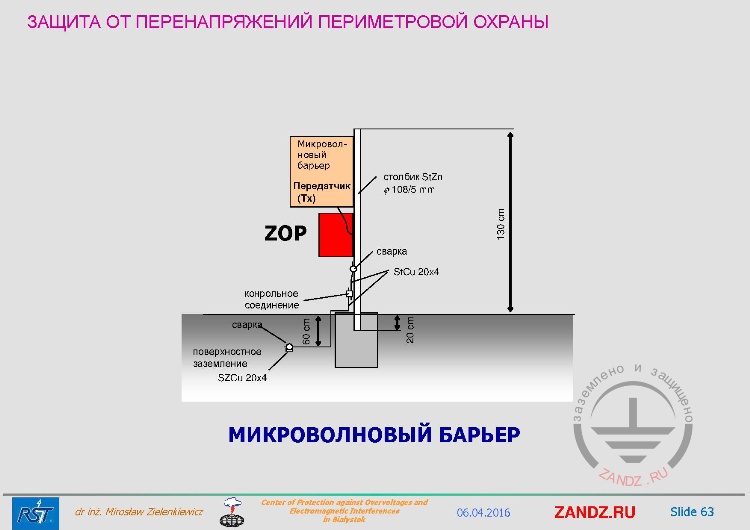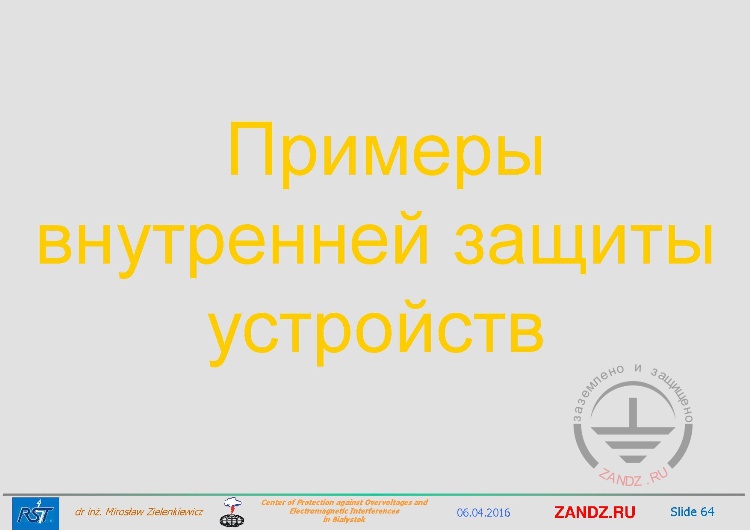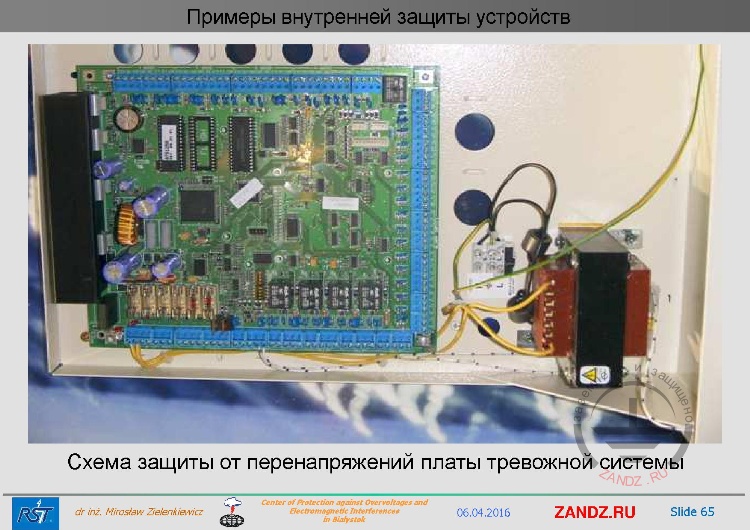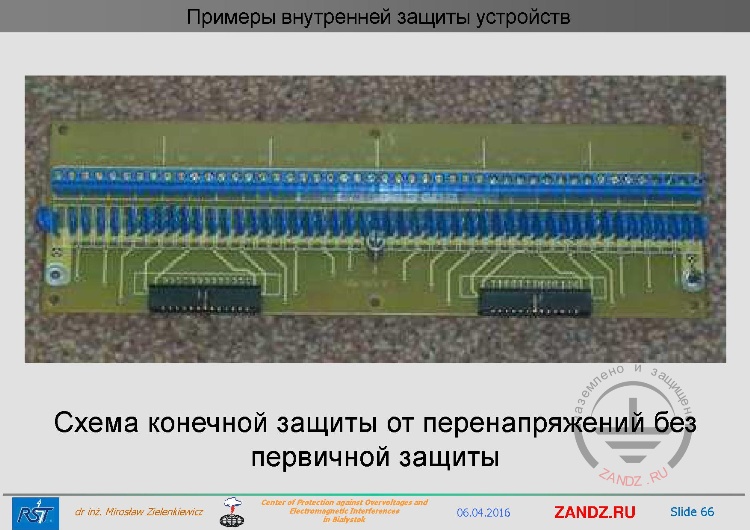The 4th webinar about Surge Protection
Webinar text. Page 5
Quick slide navigation:
1. Rules of surge suppressors selection
2. About Miroslaw Zielenkiewicz
3. Lightning Electromagnetic Pulse Protection
4. Thunderstorm Electromagnetic Pulse Protection
5. Electromagnetic environment (IEC 50155)
6. Protected device with surge suppressor
7. Object geometry
8. Surge suppressor at the cable entry of the object
9. Two-stage protection system of signalling link
10. Stage 1. Determination of device stability
11. Example for railway devices
12. Table of port stability
13. Stage 2. Master data definition
14. Basic technical data of the electronic system
15. Differential and longitudinal interference
16. Wave impedance of signalling link
17. Stages 3 and 4 of protection devices selection
18. Gas-filled arrester
19. Energy Distribution of Surge Arrester
20. Multi-stage circuits
21. State standard IEC 61643-21-2014
22. Stage 5. Determination of the number of protective degrees
23. Stage 6. Determination of maximum allowable voltages
24. Stage 7. Determination of the method of signal transmission
25. Stage 8. Determination of the maximum signal voltage
26. Stage 9. Determination of the nominal frequency of operating signals
27. Stage 10. Selection of surge protection circuit
28. Stage 11. The choice of the method of grounding the device
29. Indirect grounding of the screen
30. Stage 12. Estimation of device connections
31. Examples of surge protection
32. Security and alarm system protection
33. Layout of security elements
34. Protection of the central point
35. Microwave barrier protection
36. Protection circuit of the microwave barrier
37. CCTV security protection
38. Surge protection of the video cameras
39. Protection circuit of the CCTV security
40. Protection of a video camera
41. Protection circuit of the CCTV
42. Surge protection of multiplexer
43. SPDs for the protection of the CCTV
44. Light pole with video camera
45. Protection circuit of the RST-safe CCTV
46. Installation manual of the arrester in the shield
47. 75 Ohm video signal lines
48. RST-safe CCTV
49. Example of the video camera protection on the roof
50. Surge protection of sports facilities
51. Football stadium, 2004
52. Loudspeaker outriggers
53. Surge protection shield
Page 5:
54. Operation of protecion elements
55. Light indicator as a fault signalling
56. Surge protection of extensive systems
57. Surge protection of perimeter security
58. Perimeter protective belt
59. Cable laying under the ground
60. Perimeter protection of alarm system
61. Example of the object - tower
62. Microwave barrier
63. Examples of internal device protection
64. Protection circuit of the alarm system board
65. Final protection circuit without primary protection
Operation of protection elements
— This practical operational issue: what to do with such points as here? Someone came up with it because there was a need. How to use and examine the state of overvoltage protection elements then – it is simply impossible in this case.
Light indicator as a fault signaling
— And here the fault signaling is installed that turns on a light indicator when the element burns out. But at night, security may see it.
Surge protection of extensive systems
| ЗАЩИТА ОТ ПЕРЕНАПРЯЖЕНИЙ ОБШИРНЫХ СИСТЕМ | SURGE PROTECTION OF EXTENSIVE SYSTEMS |
| ПЕРИМЕТРОВЫЕ ОХРАННО – ТРЕВОЖНЫЕ СИСТЕМЫ | PERIMETER SECURITY AND ALARM SYSTEMS |
— Another example is perimeter security and alarm system. When we select overvoltage protection, it also has a great importance, because of its dimensions. Cable lengths there reach 100, 200 and sometimes 300 meters and it is clear that they will always induce more overvoltage in them than with such small local systems.
Surge protection of perimeter security
| ЗАЩИТА ОТ ПЕРЕНАПРЯЖЕНИЙ ПЕРИМЕТРОВОЙ ОХРАНЫ | SURGE PROTECTION OF PERIMETER SECURITY |
— Please look, even in this case, this is a cable point.
Perimeter protective belt
|
ЗАЩИТА ОТ ПЕРЕНАПРЯЖЕНИЙ ПЕРИМЕТРОВОЙ ОХРАНЫ |
SURGE PROTECTION OF PERIMETER SECURITY |
|
Защитный пояс периметра ~ 8500 м |
Perimeter protective belt ~ 8500 m |
|
Aпериметра ~ 416 000 м2 |
Aperimeter ~ 416 000 m2 |
|
Защитный пояс периметра ~ 8500 м |
Perimeter protective belt ~ 8500 m |
|
Дополнительный объект надзора расстояние от пояса периметра ок. 500 м |
Additional object of surveillance distance from the perimeter belt is approximately 500 m |
|
Основной объект надзора (караульная), расстояние от пояса периметра ок. 100 м |
The main object of surveillance (guard), |
|
Лесистая территория |
Woodland |
|
Наружное ограждение |
Outside fence |
|
Внутреннее ограждение |
Indoor fence |
|
Лесистая территория |
Woodland |
— Take a look as an example, image here is a little bit unclear. Can you zoom in here? I did that.
— Miroslaw, I'm sorry, I'll interrupt you. Dear colleagues, please use the magnification tools. They are located under the presentation, the zoom with a green plus or red minus. If Miroslaw zooms in on the picture at home, it is not zoomed in for you automatically.
— Well, if it is not visible there, then zoom in. This object, for our purpose, is indicated simply as a large fence. Perimeter belt length is about 8.5 km. Such objects definitely exist. Inside it we see the main object of surveillance, such as a guard at a distance of one hundred meters from the perimeter belt, so the cable is at least one hundred meters with a sensor and more. And some additional object of surveillance at a distance of 500 meters from the perimeter. Also look at the cable lengths that will be longer. You see that right away. And, based on the threat assessment, we consider contraction zones to such an object about 416,000 m2.
Laying cable under the ground
| ЗАЩИТА ОТ ПЕРЕНАПРЯЖЕНИЙ ПЕРИМЕТРОВОЙ ОХРАНЫ | SURGE PROTECTION OF PERIMETER SECURITY |
— Different detection methods are applied. In this case, the special wires are laid in the ground. And here we must immediately understand that if they are laid in the ground, then the lightning that strikes it in the ground or strikes the column, or strikes the fence, it will spread over the area, and leak to the devices through the cables that are in the ground and will leak into our devices. But here, if we look closely, we will see spark gaps installed. But it turns out that those spark gaps gave too much voltage, and the whole system burnt out. During the first strike to this object, built about 15 years ago, all security systems burnt out due to wrong selected protection and because of the inconsistency of the stability of these systems in the electromagnetic network that appeared in this place.
Perimeter protection of alarm system
| Защита тревожной системы на периметре | Perimeter protection of alarm system |
| Схема RST-9-1-10-5 | RST-9-1-10-5 Circuit |
— One of the schemes to protect the local control point that is located at the perimeter because of the length of the signal lines. And from this console is transmitted to the central with information. So we see here that such console is protected from all sensors and from the standard RST-4-8-5 data highway between the central point and the local control point.
Example of the object - tower
| ЗАЩИТА ОТ ПЕРЕНАПРЯЖЕНИЙ ПЕРИМЕТРОВОЙ ОХРАНЫ | SURGE PROTECTION OF PERIMETER SECURITY |
— An object that I have already shown, but it is good to return to such objects. The object is a tower about which we have already started talking today, where the object is by the sea and where, for some reason, on a rising ground, the lightning strikes often. And please look, all sensors have local protection, motion sensors, all barriers. Here the receiver and transmitter, all have SPDs.
Microwave barrier
| ЗАЩИТА ОТ ПЕРЕНАПРЯЖЕНИЙ ПЕРИМЕТРОВОЙ ОХРАНЫ | SURGE PROTECTION OF PERIMETER SECURITY |
| Микроволновый барьер | Microwave barrier |
| Передатчик | Transmitter |
| столбик StZn | StZn Stake |
| сварка | welding |
| контрольное соединение | control connection |
| поверхностное заземление | surface grounding |
| МИКРОВОЛНОВЫЙ БАРЬЕР | MICROWAVE BARRIER |
— The figure is repeated. That is, we install SPDs everywhere locally. There must be an SPD, in Polish we call it ZOP, where we protect all the wires passing through such a barrier. I can say that when we worked in the nuclear power plant and guard perimeter had stopped burning out, the problems immediately disappeared. Without such elements it is simply impossible.
Examples of internal device protection
| Примеры внутренней защиты устройств | Examples of internal device protection |
— Let's look at an example of the internal protection of devices that manufacturers supply.
Surge protection circuit of the alarm system board
| Схема защиты от перенапряжений платы тревожной системы | Surge protection circuit of the alarm system board |
— We cannot say that they absolutely do not understand what a threat is. And if only for their devices to pass tests for electromagnetic compatibility, they installed here, for example, varistors. This is from our exhibition, it will be at the end of April, we always exhibit there. Here are the varistors, and let's think for a bit, what happens when these elements trigger? That is, according to ideology, everything is fine, but in this case we allowed the overvoltage to pass to our board with a microprocessor system, so that here the surge current flew through the element.
Final protection circuit without primary protection
| Схема конечной защиты от перенапряжений без первичной защиты | Final protection circuit without primary protection |
— Example: a varistor circuit that is located at the end of 200-300 meters cable cores. It had to protect some kind of gas station. It is simply impossible. These elements simply burnt out. And after local grounding these elements simply burnt out. All wrong. Today I have prepared so much, I hope that I have more or less explained everything. What do we do next, Aleksei? I read the questions, I see one: "In the continuation of my question, can you send the link to the standard technical documentation of the RF that regulates the requirements for laying and lightning protection of communication cables?"
— Yes, Miroslaw, thanks for the report. Today we finished on time. The question came from Dmitrii, he already asked the first question about screened communication cables and this is an addition to it. Dear colleagues, if you have more questions on the report or even surge protection, in particular low-current lines, please send them to the chat or to our email.
— Dmitrii, excuse me, please, but I do not completely understand your standards.
— Thank you, Miroslaw! If you have questions later, please, send them to our email address. Once there are no questions, we may finish the meeting. Thank you all for coming today. Miroslaw, a special thank you for the report. Dear colleagues, please register to the next webinars. I will send the link to the chat again. Thank you all, see you again soon!
— Thank you all! Thank you, Aleksei. At the next webinar we will talk about the elements in more details, show what kinds of them exist. Good bye!
Do you have any questions? Ask our technical experts and you will receive detailed substantiated answers.
<< Previous page
slides from 40 to 53
Useful materials for designers:
- Webinars with leading industry experts
- Everything for calculations of grounding and lightning protection
- Useful materials: articles, recommendations, examples
Related Articles:


